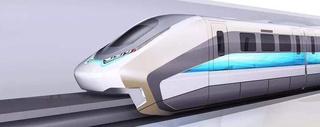Traditional Shinkansen vs Maglev
The history of Shinkansen, also known as the bullet train, goes back to the early 60s. This is when the first of its kind, the 0 Series Shinkansen, started operating on the Tokyo-Osaka line. The first bullet train was a pioneer of its time operating at speeds of 210 km/h (130 mph). Class 1000 Shinkansen was the prototype version of this train and it held the world record for the highest speed for electric trains in 1963 with a top speed of 256 km/h (159 mph). Shinkansens have been advancing ever since. Gaining more aero-efficient designs and breaking speed records. We are going to compare the current most advanced high-speed rail Shinkansens with the Japanese SCMaglev train.
N700S Series Shinkansen
The N700 series high-speed train is Japan's most advanced Shinkansen with tilting capability that has been in operation since 2007. The N700S is the latest iteration that was unveiled by JR Central in 2018. The "S" stands for Supreme. It's capable of running on the built-in lithium-ion batteries in case of a power outage or earthquake. These new trains will enter commercial service during the summer of 2020, in time for the Tokyo Olympics. The operational speed will be 360 km/h (224 mph). This train is also going to be used on the new high-speed rail line in Texas, connecting Dallas with Houston in only 90 minutes.
ALFA-X Experimental Shinkansen
It was unveiled during the summer of 2019, JR East is testing this new experimental train for improving future Shinkansen trains. This new design includes technology to reduce vibration as well as noise. The high-speed testing is done at speeds of 400 km/h (250 mph). By 2030 the Hokkaido Shinkansen will be extended until Sapporo and the derivation of the ALFA-X is planned to operate at speeds of 360 km/h (225 mph) on the 1,075 km (668 miles) route between Tokyo and Sapporo.
L0-Series Maglev
The magnetically levitating bullet train was unveiled in 2012, and with smaller changes, it is expected to be the basis of the production train that will serve on the Chuo Shinkansen maglev line between Tokyo and Nagoya. Commercial service between these cities set to start in 2027 with an eye-watering operating speed of 505 km/h (315 mph). As incredible as it seems, the L0 is easily capable of holding this pace as its world record run was 603 km/h (375 mph).
Traditional Shinkansen vs Maglev Bullet Train in Numbers
The L0 Series maglev bullet train is quicker and sleeker than its traditional counterpart, the N700S Series Shinkansen. The magnetically levitated train has a much higher top speed as well as nearly double the acceleration-rate. The L0 Series reaches 603 km/h (375 mph) in under 4 minutes, while the N700S Series takes 3 minutes to reach 270 km/h (168 mph). The aerodynamic shape translates to a sleeker body. The maglev train is narrower and shorter, which will mean less spacious interior but a quicker journey.






